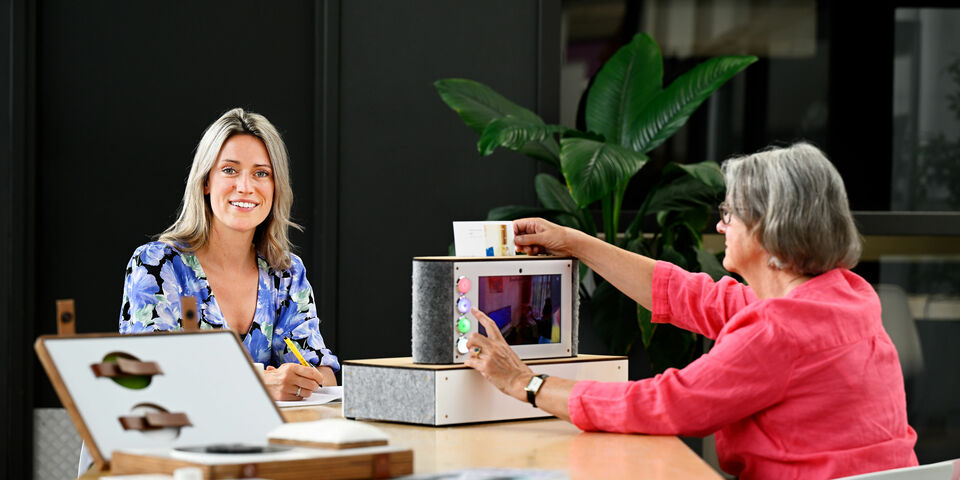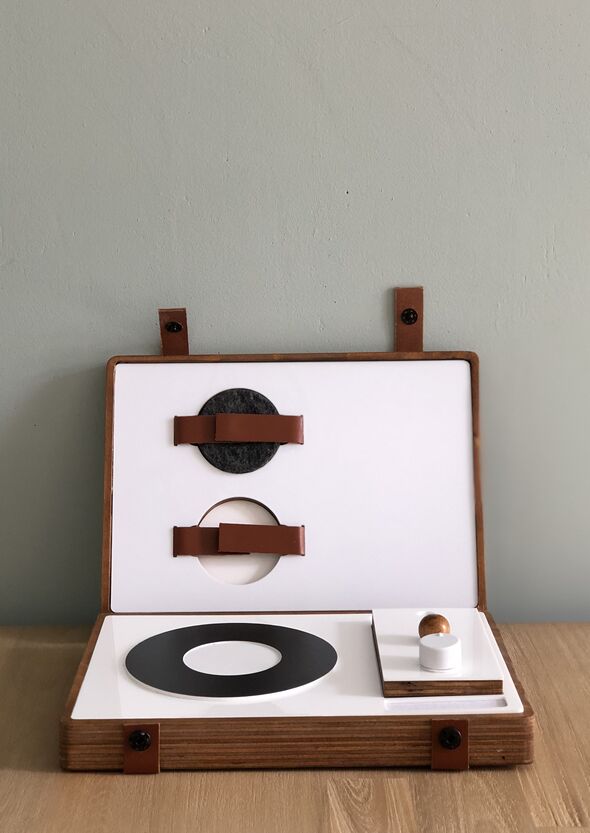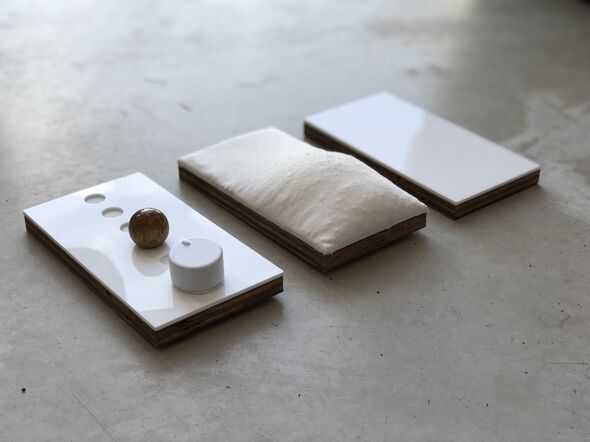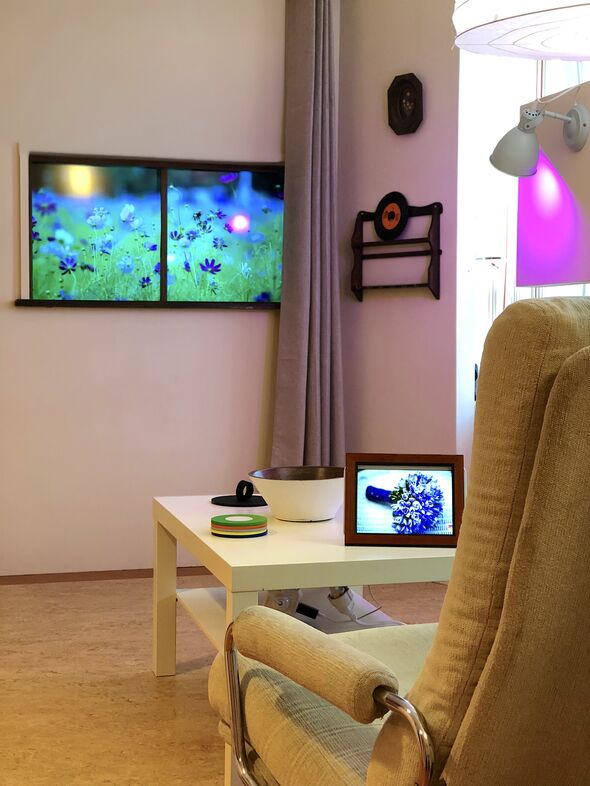Home Stretch | Creating valuable moments
‘Warm technology’ can support people with dementia with their psychosocial needs. PhD candidate Myrte Thoolen, who will be defending her dissertation at the Department of Industrial Design today, observed that existing technology often doesn’t quite hit the mark. Working closely together with healthcare organization Pleyade’s Innovation Team, she took stock of the needs of people with dementia. This led, among other things, to a design for an installation that automatically adjusts to the personal requirements of whoever uses it.
Over the past few years, the PhD candidate engaged in close collaboration with Stichting Pleyade, which provides care to people with dementia. In the context of the Pleyade Innovation Team, she worked together with other researchers, designers, technicians, and care and welfare professionals. While carrying out her research she also had a lot of direct contact with people with dementia and their loved ones. “To be able to see things from their perspective, I started my PhD research by observing and participating in organized daytime activities for people with dementia.”
Rich stories and memories
“I remember coming home one day and thinking: I didn’t even notice that these people have dementia,” she continues. “That really triggered me.” According to Thoolen, we tend to assume that dementia drastically changes people and renders them unable to do many things. But when she talked to them, it became obvious they still had very rich stories and memories. “That’s when I realized that we should see these people for what they are, instead of labeling them right away. And, importantly, we should look at what they can do and help them do it, rather than focusing on what they can’t do anymore.” This became the point of departure for her research.
Although in literature a lot has been theorized about dementia, she quickly noticed that its practical impact differs from person to person. You can use ‘warm technology’ to empower people with dementia, but Thoolen saw a big gap between existing technology and individuals living with the syndrome. This meant that right from the start, her goal was to develop technology that better met individual needs and that could be adjusted to the users’ requirements. She went about attaining this goal with a positive approach: how can we empower people, enrich their daily experiences, create fun moments and, in so doing, improve the quality of their lives? She used design research and collaborated with people with dementia to develop the three systems she presents in her dissertation.
Different interfaces
The warm technology designed by Thoolen relies heavily on media. “Music, videos and photos can encourage conversation, improve people’s emotional wellbeing and make a very positive contribution to the invocation of memories,” she says. However, people with dementia have little access to these kinds of media systems themselves. They may not be able to turn on a radio, for example, let alone use modern music systems such as Spotify. Focusing on what they can do still allowed her to design Sentic, a music system that people with dementia can operate themselves.
The system has three interchangeable interfaces to meet individual users’ needs. The system is operated using buttons, “which is a feature of old radios and other devices people may remember from back in the day,” says Thoolen. But there’s also an interface with a soft surface they can touch to control the system. “When they move their fingers up, the music gets louder, and when they move them down, the volume decreases,” she explains. “One gentleman tried it and was completely perplexed, yelling out to the other people in his group: ‘Guys, I did that!’”.
The final interface does not have a control function, allowing the user to concentrate solely on the music, which can also be personalized. By matching music discs to the right shapes (“The workshops revealed that most of them can do it”), users can activate the system and play music of their choice.
Interactive installation
Another design, AmbientEcho, consists of an installation that uses a combination of different media to provide positive stimuli to people with dementia. What makes this interactive installation special is that the media content automatically adjusts to the person using it. As a result, the installation would be perfect for care facilities with many different residents. A Bluetooth necklace enables identification of whoever is in range of the installation and the images, photos, videos and lighting automatically change to the content that has been preset based on personal preferences.
“Personalizing the media content can also have a negative effect on people with dementia, as it may aggravate feelings of loss and absence. That’s why we created both custom and generic music and images to see how people would react. It turns out this varies strongly,” Thoolen explains. “Some people find it very pleasant to see general images, for instance flower fields or the sea. But there was also a gentleman who was a big fan of Vitesse football club, so he loved it when we programmed the installation accordingly.”
LivingMoments
She also designed LivingMoments, a system that allows people to receive text, video and audio messages from loved ones. The device turns text messages into printed postcards, which can then be activated (see main photo). The QR code enables the system to recognize who sent the card and play an audio or video message from the same person. The recipients can react to the messages using an emoticon (such as a thumbs-up or a heart), a typed message, or an audio or video response, whichever they prefer. “Some can still type a message, whereas others like to react using emoticons,” the PhD candidate says.
The system is basically a simplified alternative to WhatsApp. “Most people with dementia can’t operate a smartphone. Their partner may show them any incoming messages or videos, but this is often done very quickly before the phone is taken away again,” Thoolen says. “Someone else determines when they get to see the message, so they’re no longer in control themselves.”
This system returns the ability to independently keep in touch with family and friends to people with dementia. “Even the grandchildren were able to send a message and get something in response, thereby interacting with their grandparent with dementia.” This made it an enriching, shared experience for both the people with dementia and their loved ones. “My research also suggests that in addition to people with dementia, we need to involve the social environment in designing technology. After all, this environment influences how the technology is used,” Thoolen emphasizes.
Adjustability
According to Thoolen, the adjustability of these kinds of systems to personal preferences is very important and warrants further research. “In the literature it is often said that we need to adjust the technology to the needs, but the ‘how’ tends to be lacking. The studies making up my dissertation demonstrate the opportunities in this respect,” says Thoolen. “Also, the Pleyade Innovation Team illustrates the importance of introducing these kinds of interdisciplinary teams – including design teams – to the care and welfare domain. These teams can then work together with the target group, in this case people with dementia, to develop suitable technology that meets the latter’s needs and requirements.”
For the moment there is no business plan for the large-scale provision of the three designed systems to people with dementia, but Stichting Pleyade will in any case keep using the working prototypes. “The research has been very rewarding,” the PhD candidate says in closing. “What’s most important to me is that I was able to make a positive contribution to the lives of people with dementia.”





Discussion